Characteristics and description of the sweet cherry tomato variety, yield and cultivation
If you have never grown cherry tomatoes in the country, start next season with the Sweet Cherry F1 hybrid. It has been popular for a long time. A successful hybrid combines all the best features of this type of tomato:
- yield;
- unpretentiousness;
- excellent taste;
- marketable fruits.
Description
Sweet cherry tomato ripens very quickly. The first hands begin to mature at 75 days of age. Ripening period 75-80 days is a group of ultra-early ripening tomatoes, and it belongs to it.
The bushes of this variety are called the candy tree among gardeners. Most likely, the name should be associated with the sweetness of the fruit. Growing is not limited to open ground, temporary shelter or greenhouse. Many vegetable growers practice indoor keeping.
Tomatoes can be grown in a pot of the required size. Bushes with clusters of 30-50 small fruits look elegant, this is clearly seen in the photo. Color scheme Sweet cherry is a mixture of three colors:
- Yellow;
- Red;
- Orange.
Fruits contain up to 12% dry matter. They are very sweet with dense juicy flesh. Fruits weigh little - 20-30 g, have an excellent, sweet taste.
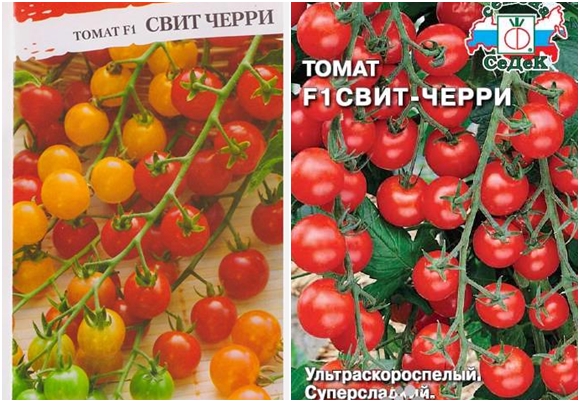
About yield and specificity of the variety
The growth characteristic corresponds to the indeterminate type. Tomatoes of this group grow up to 2 m. The bushes show a higher yield with a 2-trunk formation scheme.
When using this scheme, 1 stepson is left on the central stem. It is located in the bosom under the first inflorescence. A second stem is formed from it, and all the stepsons above it are pinched off.
Reviews
Alexey, Omsk
Planted Sweet cherry for 8 years. The variety has no problems: it does not get sick, bears fruit for a long time. It doesn't fill up with tomatoes, but it ripens early and the tomatoes are sweet. I am not engaged in the formation of a bush; if possible, sometimes I remove stepsons. Bushes grow in 3-4 stems. I don't plant a lot of this variety, no more than 4 bushes.
Alexander, Vitebsk
For those who have not planted this variety, I recommend - do not plant. Sweet cherry tomatoes were grown in a greenhouse. My description:
- They sing late.
- The harvest is low.
- They occupy a large area.
- Not sweet.

Galina, Leningrad region
I will plant these tomatoes next season. Sister treated Cherry from her garden. I liked both the taste and the color. I will definitely try.
Reviews are not unambiguous, but the variety should not be blamed for this. The taste and yield depend on the quality of care and seeds.
Care and growing rules
Cherry tomatoes grown through seedlings. The timing of sowing seeds is calculated according to a simple scheme. 60 days are subtracted from the estimated date of transplantation. For example, you are planning plant tomatoes in a polycarbonate greenhouse... In your climate, this is possible on April 20.This means the seeds can be sown on February 20th.
To sow seeds, prepare:
- The plastic box is low.
- Purchased fertile soil, consisting of garden soil, humus and two types of peat.
- For picking seedlings, peat or plastic cups.
- Any liquid fertilizer for seedlings.
- Daylight lamp for plant illumination.
Council. Cherry bushes with fruits of red, yellow, orange color will decorate the greenhouse or vegetable garden. Buy seeds of different colors.
Sow seeds in moist soil. Sprinkle 1 cm of humus or loose soil. Cover the box with the planted seeds with foil or put in a regular bag. The optimum room temperature is 25 ° C.
For strong seedlings:
- dive in the 2-leaf phase;
- water at least 1 time per week;
- highlight tomatoes in cloudy weather;
- feed at least 1 time 2 weeks before transplanting into the ground.

Transplant and summer care
Transfer the seedlings ready for transplanting to a greenhouse or greenhouse and adapt them to new conditions within a week. At the same time, prepare the ridge:
- Add humus 1 bucket.
- Superphosphate 2 tbsp. l.
- Potassium nitrate 2 tbsp. l.
- Ammonium nitrate 1 tbsp. l.
- Dig the ridge to a depth of 25-30 cm, level it with a rake.
- Prepare the wells, observing an interval of 50 * 40 cm.
The dosage is given for approximately 1 m² of the bed. Assuming that the soil is light, loamy with normal acidity. If the soil is acidic for digging, add ash or chalk. Heavy clay soil will be improved by river sand (0.5 buckets / m²).
Transplant seedlings by transshipment, water and forget for 2 weeks. While it is growing, it does not need to be watered or fed. If the weather is sunny, shade with a covering material, it will also save you from spring frosts.
Summer work
Summer care for this type of tomato is standard. It includes:
- Watering 1-2 times a week.
- Top dressing.
- Loosening of row spacings with simultaneous removal of weeds.
- Bush formation, regular removal of stepchildren.
- Prevention and control of diseases and pests.
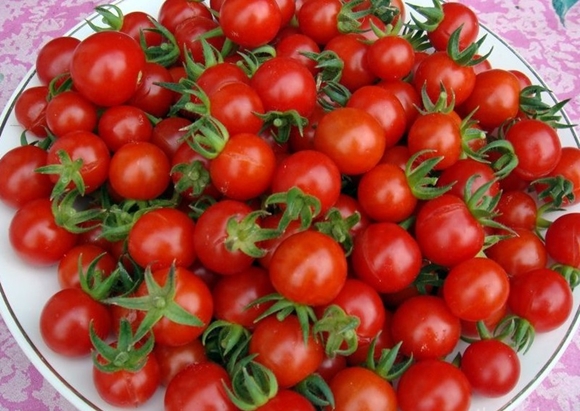
Watering is abundant. The ground should get wet enough. If the weather is not hot, 1 heavy watering per week is enough. Feed for the first time 2 weeks after transplantation.
You can prepare a herbal infusion with the addition of urea and carry out the first 2 feeding with it. 1 liter of strong herbal infusion is enough for a bucket of water.
In the second half of summer, fertilize cherry with phosphorus-potassium fertilizers. When day and night temperatures fluctuate, spray the bushes with a solution of boric acid. Top dressing is a good disease prevention. They strengthen the immune system of tomatoes.
Airing, loosening and mulching of the soil under the bushes save from late blight in the greenhouse.
In the open field, late blight affects plants in rainy weather. Bushes planted according to the recommended scheme - formed in 2 stems, it is not terrible. Mulch made from dry grass, straw or shredded branches will provide additional protection for shrubs from fungal spores and root rot.
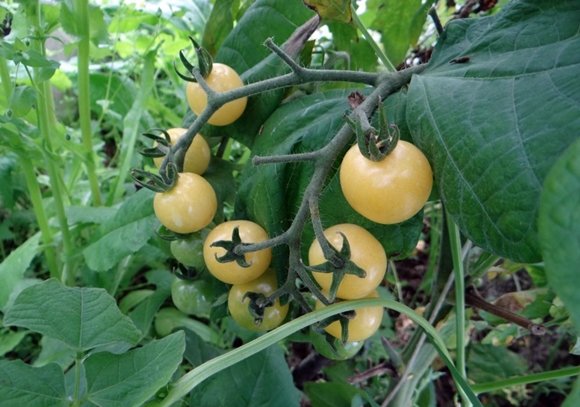
Conclusion
Several bushes of colorful cherry tomatoes will decorate a vegetable garden or greenhouse. Multi-colored small fruits will delight in early summer. It is a treat for children and a gourmet treat.
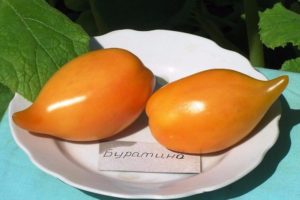

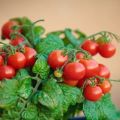
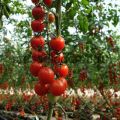
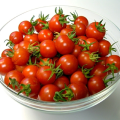
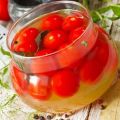
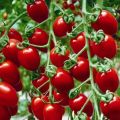
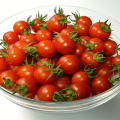

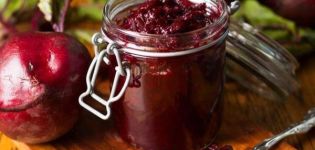
This is my favorite tomato variety. It is so convenient to grow, collect and cook.I plant seedlings in February, in May in a greenhouse, fertilize with BioGrow, a bioactivator of growth, and in mid-July we eat our cherry trees. I bought it in this store.